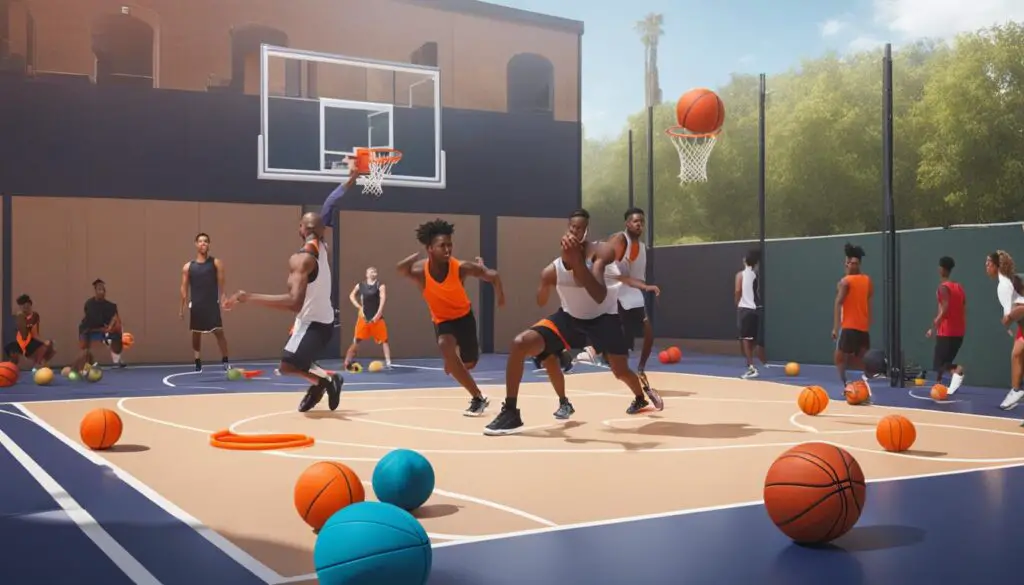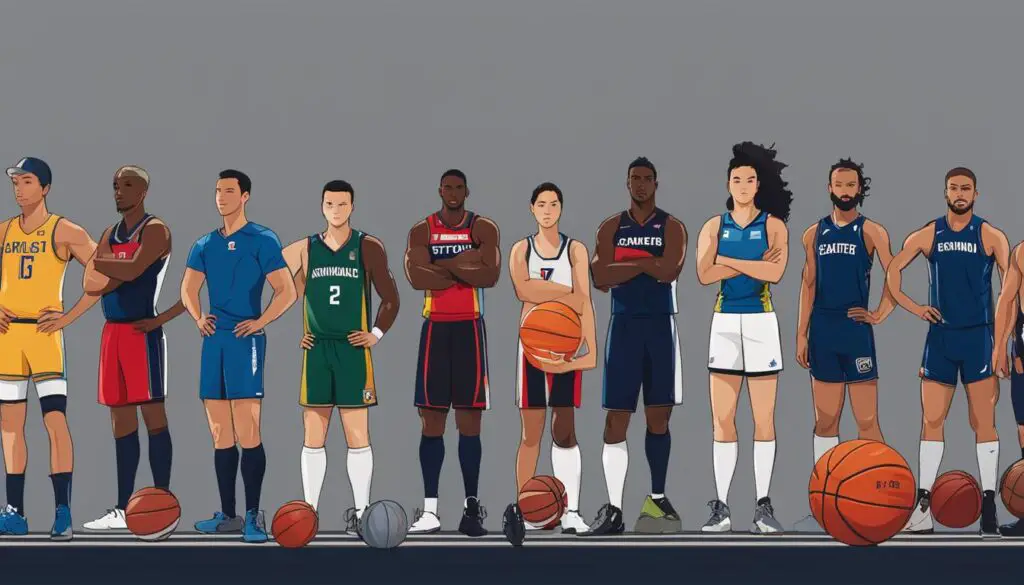Basketball players are known for their towering stature, but have you ever wondered why they are so tall? The average height of basketball players is significantly above the average population, and it’s not just a coincidence. Genetic factors play a crucial role in the height of basketball players, contributing to their competitive advantage on the court. Understanding the reasons behind the tall stature of basketball players can shed light on the uniqueness of the sport.
Key Takeaways:
- Genetic factors contribute to the tall stature of basketball players.
- The average height of basketball players is significantly higher than the average population.
- Tall stature provides competitive advantages in terms of reach, shooting angles, and defense.
- While height is important, skills, mindset, and other factors also contribute to a player’s success.
- The correlation between height and success extends to other sports as well.
The Role of Genetics in Basketball Player’s Height
Genetic factors play a significant role in determining the height of basketball players. Many professional basketball players have genetic variations that contribute to their tall stature. These genetic factors include a combination of genes that regulate bone growth, hormone levels, and skeletal development. The presence of these genes gives basketball players a natural advantage in terms of height, allowing them to excel in the sport.
Height genetics in professional basketball players can be attributed to a variety of factors. One key factor is the regulation of bone growth. Certain genes influence the growth of long bones, such as the legs and arms, resulting in increased height. Additionally, genes involved in hormone production and signaling can impact the overall growth and development of an individual, influencing their height.
Research has shown that specific genetic variations are more prevalent among professional basketball players, contributing to their tall stature. For example, a study conducted on professional male basketball players found a higher frequency of the ACVR1B gene variant, which is associated with increased height. This genetic advantage allows basketball players to reach greater heights, improving their performance on the court.
There are several advantages of height in basketball. The most obvious advantage is an improved reach, which enables players to block shots, grab rebounds, and shoot over opponents more easily. Taller players have a larger wingspan, allowing them to cover more area on the court and disrupt the opposing team’s offense. Height also provides a physical advantage when it comes to defending the basket and contesting shots.
“Height genetics play a significant role in basketball player’s height, giving them a natural advantage on the court.”
Height Requirements for Basketball
When it comes to basketball, height requirements are often a key consideration, both at the amateur and professional levels. Taller individuals naturally have an advantage in the sport due to their ability to reach higher and cover more area on the court. In fact, the average height of professional basketball players significantly exceeds that of the general population, with many players surpassing 6 feet 6 inches in height.
So, what are the benefits of height in basketball? Let’s delve into a few:
- Better Shooting Angles: Taller basketball players have a higher release point when shooting the ball, providing them with better shooting angles. This advantage allows them to shoot over defenders more easily and increases their scoring efficiency.
- Contesting Shots: Height enables players to contest shots effectively. With their long arms and elevated reach, taller individuals can block or alter opponents’ shots, making it challenging for them to score.
- Rebounding Ability: The ability to grab rebounds is a crucial skill in basketball, and height plays a significant role in this area. Taller players have a greater advantage when it comes to snatching rebounds, as they can reach higher and grab the ball over smaller opponents.

The Impact of Height on Success in Basketball
Height plays a crucial role in the success of basketball players. It is a well-established fact that taller players have a higher chance of achieving success in the sport. The increased height provides numerous advantages on the court, influencing scoring, defense, and overall performance. It comes as no surprise that many of the greatest basketball players in history, such as Michael Jordan, Magic Johnson, and Shaquille O’Neal, were above-average height.
While height is not the sole determining factor for success in basketball, it is undeniably a significant attribute that contributes to a player’s performance. Taller players have an inherent advantage when it comes to reaching for rebounds, blocking shots, and shooting over opponents. They can alter the trajectory of shots with their towering presence, making it difficult for shorter players to defend or contest their attempts.
Height also plays a role in scoring efficiency. A taller player can shoot over defenders, utilizing a higher release point that makes it harder for opponents to block their shots. Additionally, taller players often have longer strides, allowing them to cover more ground with fewer steps and make towering dunks that energize the crowd and their teammates.
Furthermore, height provides defensive advantages. Taller players have longer wingspans, enabling them to disrupt passing lanes, block shots, and contest opponents’ shots effectively. They can cover more ground on defense, making it difficult for opposing teams to find open scoring opportunities. This defensive prowess can swing the momentum of a game and lead to turnovers and fast-break opportunities for their team.
However, it is important to note that while height is advantageous in basketball, it is not everything. Skills, such as shooting accuracy, ball-handling, court vision, and basketball IQ, are equally essential. Mental fortitude, work ethic, teamwork, and leadership abilities also contribute to a player’s overall success in the sport.
Understandably, height is a natural advantage that cannot be taught or acquired through practice. Nevertheless, players of average or shorter stature can still excel in basketball by honing their skills, using speed and agility to their advantage, and making smart decisions on the court. It is the combination of physical attributes, skills, and mental aptitude that ultimately determines a player’s success in basketball.
The Physical Impact of Height on Basketball Players
Height in basketball can have both positive and negative effects on players’ physical well-being. Taller players often face unique challenges, such as an increased risk of injuries and health issues related to their size. The excessive load placed on joints and the musculoskeletal system can lead to increased wear and tear, making taller players more prone to injuries.
Additionally, certain health conditions, such as Marfan Syndrome, may be more prevalent in taller individuals. It is crucial for basketball players to maintain proper conditioning and take precautions to prevent injuries associated with their height.

Understanding the physical impact of height on basketball players is essential for both players and coaches. By being aware of the potential risks and challenges, appropriate measures can be taken to ensure the health and well-being of athletes.
Stay tuned for the next section, where we will discuss notable examples of tall basketball players and their impact on the sport!
Examples of Tall Basketball Players
Throughout the history of basketball, there have been numerous examples of exceptionally tall players who have made a significant impact on the sport. These players have showcased the advantages of height in basketball and have left a lasting legacy in the sport. Let’s take a closer look at some of the tallest basketball players in history:
| Player | Height |
|---|---|
| Manute Bol | 7 feet 7 inches |
| Gheorghe Mureșan | 7 feet 7 inches |
| Yao Ming | 7 feet 6 inches |
Manute Bol, Gheorghe Mureșan, and Yao Ming are just a few examples of the tallest basketball players in history. Their towering stature provided unique opportunities for impressive blocks, rebounds, and scoring abilities. These players not only showcased their exceptional height but also demonstrated their skills and dominance on the court. Their contributions to the sport have had a lasting impact, inspiring future generations of tall basketball players.
These tall basketball players have not only captivated fans with their impressive physical presence but have also revolutionized the game with their skills and abilities. Their success serves as a testament to the advantages that height can provide in basketball, from altering shots with their towering presence to dominating the inside game with superior rebounding ability.
The Average Height of Basketball Players
When it comes to basketball players, one characteristic that stands out is their height. On average, basketball players tend to be much taller than the average population. This height advantage plays a significant role in their ability to excel in various aspects of the game. Let’s explore the average height of basketball players and its impact on their performance on the court.
In professional basketball, the average height of players is approximately 6 feet 7 inches. This is significantly taller than the average height of individuals in the general population. It is not uncommon to see players exceeding 7 feet in height, with towering figures dominating the court. This increased height gives basketball players an advantage in several key areas of the game.
One area where height plays a crucial role is in shooting. Taller players have a higher release point, making it more challenging for defenders to block their shots. They also have a better shooting angle, allowing for a higher success rate when shooting over opponents. Additionally, height enhances a player’s rebounding abilities, as they can reach higher to grab missed shots and secure possession for their team.
Defensively, height is a valuable asset. With longer wingspans, taller players can disrupt passing lanes, contest shots, and block opponents more effectively. Their physical presence alone can intimidate opponents, influencing the dynamics of the game and forcing adjustments in the opposing team’s strategies.
It is important to note that while height provides a significant advantage in basketball, it is not the sole determining factor for success. Skills such as agility, speed, shooting accuracy, and basketball IQ also play crucial roles in a player’s performance. However, the average height of basketball players showcases the clear relationship between height and the competitive edge it can provide on the court.
Factors Beyond Height in Basketball Success
While height is undoubtedly an advantageous factor in basketball, there are several other crucial elements that contribute to a player’s overall success on the court. In addition to physical attributes, skills such as shooting, dribbling, passing, and basketball IQ play significant roles in determining a player’s performance.
Skills in basketball are fundamental to excel in the sport. A player’s ability to shoot accurately, handle the ball effectively, make precise passes, and make smart decisions on the court are all essential factors that contribute to their success. While taller players may have inherent advantages, developing and refining these skills is necessary to reach their full potential.
Moreover, factors beyond physical attributes and skills also come into play. A strong work ethic is crucial for basketball success. Hard work, dedication, and continuous improvement in practice are instrumental in honing a player’s abilities and setting them apart from the competition.
Mindset and mental toughness also play vital roles in a player’s success. Basketball is a mentally demanding sport, and players need to have the resilience to overcome challenges, stay focused during high-pressure situations, and maintain a positive attitude despite setbacks.
Teamwork is another vital aspect of basketball success. Players must learn to work cohesively with their teammates, communicate effectively, and understand their roles within the team. Building strong relationships and being a team player contribute to collective success on the court.
Overall, while height is an advantageous factor in basketball, skills, mindset, work ethic, and teamwork are equally essential components that contribute to a player’s success. Emphasizing the development of these factors alongside height can lead to well-rounded players who can make significant contributions to their teams.

The Correlation between Height and Other Sports
Height is not unique to basketball; it also correlates with success in other sports. Athletes who possess taller statures often have advantages in various athletic endeavors. One such sport is volleyball, where height plays a crucial role in blocking and spiking. Taller individuals are more likely to excel in these areas due to their increased reach and ability to cover more ground on the court. The correlation between height and success extends beyond basketball, highlighting the significance of physical attributes in achieving optimal sports performance.
Understanding this correlation provides valuable insights into the role of genetics and physicality in different sports. It emphasizes the impact that height can have on an athlete’s performance, particularly in sports that require vertical reach, such as volleyball. Tall athletes in various sports showcase the advantages that height brings, demonstrating how physical attributes can contribute significantly to success on the field or court.

The Role of Height in Volleyball
In volleyball, height is a desirable attribute that can elevate an athlete’s performance. Taller players have an increased advantage in blocking, as they can reach higher to intercept and redirect their opponents’ shots. Furthermore, their height enables them to generate more power and accuracy behind their own spikes, making it more challenging for opponents to defend.
Statistical data reveals a notable correlation between the height of volleyball athletes and their success on the court. The position of middle blocker, which typically requires a tall and agile player who can block and score efficiently, often attracts individuals with above-average height. Tall athletes such as Giba, Mariusz Wlazły, and Karch Kiraly have made significant impacts in the sport, underscoring the importance of height in volleyball.
Conclusion
The height of basketball players is not merely coincidental; it is a result of a combination of genetic factors that provide them with a competitive edge on the court. While height is undoubtedly advantageous in basketball, it is important to recognize that it is not the sole determinant of a player’s success. Other factors, such as skills, mindset, and teamwork, also play crucial roles in a player’s performance.
The intricate relationship between genetics, height, and success in basketball illustrates the complexity of the sport. Tall athletes possess unique abilities that allow them to excel in various aspects of the game, from shooting to rebounding and defending. However, their talents must be honed and developed through hard work and dedication.
It is also worth noting that the correlation between height and other sports extends beyond basketball. Sports like volleyball also attract taller individuals due to the inherent advantages that height provides in terms of blocking and spiking. This correlation highlights the importance of physical attributes in sports performance and underscores the role of genetics in shaping athletic abilities.
FAQ
Why are basketball players so tall?
Basketball players are often tall due to genetic factors that contribute to their height. These genetic variations give them a natural advantage on the court.
What is the average height of basketball players?
The average height of professional basketball players is around 6 feet 7 inches, with some players exceeding 7 feet.
What genetic factors contribute to the height of basketball players?
Genetic factors that affect bone growth, hormone levels, and skeletal development play a role in the height of basketball players.
What are the advantages of height in basketball?
Height provides advantages such as improved reach for blocking shots, rebounding, and shooting over opponents.
Are there height requirements for basketball?
Height requirements are not standard, but taller individuals have an advantage in basketball due to their ability to cover more area on the court.
Does height contribute to success in basketball?
Taller players statistically have a higher chance of achieving success in basketball due to increased scoring and defensive abilities.
What physical impacts does height have on basketball players?
Taller players may have an increased risk of injuries and health issues related to their size, such as joint wear and tear and certain conditions like Marfan Syndrome.
Can you provide examples of exceptionally tall basketball players?
Players like Manute Bol, Gheorghe Mureșan, and Yao Ming are examples of exceptionally tall basketball players who made a significant impact on the sport.
What factors beyond height contribute to success in basketball?
Skills like shooting, dribbling, passing, basketball IQ, work ethic, mindset, and teamwork also play crucial roles in a player’s success in basketball.
Is there a correlation between height and success in other sports?
Yes, height provides advantages in sports like volleyball, where it contributes to blocking and spiking abilities.
What are the key takeaways about the role of height in basketball?
Genetic factors contribute to the tall stature of basketball players and provide advantages in terms of scoring, defense, and overall performance on the court. However, other factors such as skills, work ethic, and mindset also play significant roles in a player’s success.
Source Links
- https://www.theguardian.com/sport/2022/nov/15/nba-basketball-height-tall-players-advantages
- https://vanguardvolleyball.com/why-are-basketball-and-volleyball-players-so-tall-exploring-the-factors-behind-the-height-advantage-in-physical-sports/
- https://www.technologyreview.com/2018/09/11/66558/biologists-checked-out-this-nba-players-dna-for-clues-to-his-immense-height/
